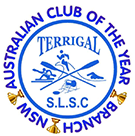The story of Dot Berry and the Terrigal Bell
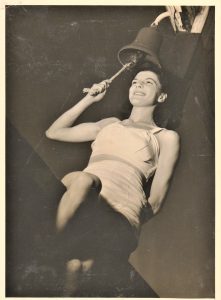
Dot Berry was born Dorothy Gambling in Paddington, Sydney in 1918.
He family moved to the Central Coast and, as Dot was the eldest of 4 girls in a family of 7, she assumed a lot of responsibility for her siblings.
The family lived at Somersby and then Gosford.
In 1935 she met Doug Berry at a dance and the rest, as they say, is history. It was a lifelong partnership.
In 1939, they married and Doug joined the RAAF and was sent to Darwin.
Dot became one of the ‘Berry Girls’.
As was normal for the woman who soon were to patrol Terrigal Beach, against all the societal norms of the time, Dot did not sit at home moping.
She was determined to do her part for the war effort and joined the National Emergency Service Patrol which was responsible for appointing air raids wardens among other duties.
She, soon after, followed her sisters-in-law Beth and Tricia, and joined Terrigal Surf Club.
Dot was one of the women who trained for and achieved her Bronze Medallion between 1942 and 1945 but was denied the qualification as women were not accepted as active Lifesavers till 1980.
She and her friends had no option but to ignore the hierarchy of SLSA as 72 of the 76 male club members had enlisted to fight in WWII, and there was no one else to patrol the beach.
This all-female patrol drew attention and a magazine spread and Movietone Newsreel were made of the women to bolster the war effort.
As Dot was a beautiful young woman, she featured in both, ringing the Terrigal bell in the PIX magazine spread and featured heavily in the newsreel.
And so, Doug was stationed in Darwin, on a hot, steamy night, distracting himself from the thoughts of active service he was awaiting, when who should fill the screen, in the “Brother, have you been saved?” Newsreel, came his beloved wife, Dottie.
“That’s my WIFE!” Doug yelled.
“Yeah, yeah, in your dreams” called out the servicemen around him, until his friend convinced them that it was true.
In an emotional letter home that night, Doug shared what it meant to him to see his beautiful wife on the silver screen when he was so far from home. That letter is still kept and treasured by their son, Grieg.
So, Doug went to war, and Dottie became an active Lifesaver and when the war was over, they were reunited and grew their family at West Gosford.
Dottie passed away in 2002 and we have her photo, her membership card and her story to keep the memories alive of that incredible time in both the club and the nation’s history.
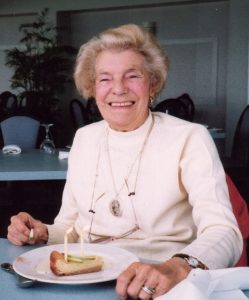
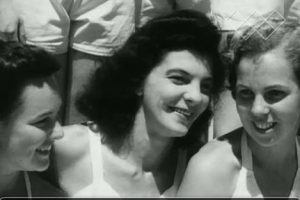
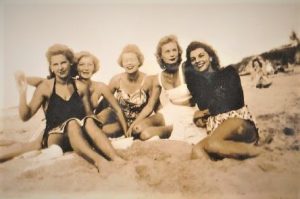
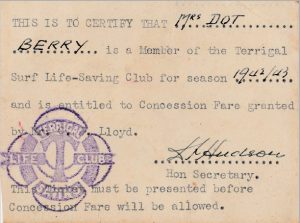
History of Terrigal Surf Club

Terrigal Surf Life Saving is charged with the responsibility of providing a safe surfing environment on one of the most popular beaches on the Central Coast of NSW used by an estimated 70,000 guests each week.
The club was established in 1920 by a small dedicated group under the leadership of the late Alistar Macarthur – Onslow. The Central Coast was one of the first regions to embrace the surf lifesaving movement and Terrigal was one of the first clubs on the Central Coast.
The Club first came into the news in 1938 when it’s boat crew was award the Royal Humane Society Certificate of Merit when attempting to rescue two people swept off the rocks into treacherous seas near the Skillion.

In 1942, with 72 of its 76 male members of the Club on military service, a group of 15 members of the Ladies Auxiliary banded together to provide water safety on the beach. Their efforts were recorded by the Daily Telegraph “To Terrigal falls the honour of having the first squad of girl lifesavers in the Commonwealth, notwithstanding the fact that they are not officially recognised by the Surf Life Saving Association of Australia”.
The Club operated initially from a shed then a one storey building until the first two storey clubhouse was constructed in 1956 near the current site. In 2001Gosford Council replaced the earlier building with the current clubhouse.

The highly popular and respected Nippers operation is an integral part of the Club which was established in 1966 as the “Sea Lions” and renamed “Nippers” in 1978. It today caters for the needs of 400 children from 6 to 14years of age.
By 1985 the number of women patrolling the beach peaked at a third of the active membership and Terrigal that year provided the Central Coast with its first all ladies patrol.
The club played host, as part of the Australian Nation’s Bicentennial Celebrations in 1988, to the Royal Surf Carnival patronised by their Royal Highnesses the Prince and Princess of Wales.
In 1992, Darren Borg a local young member and policeman was awarded the Royal Humane Society Bronze Medal by His Excellency The Rear Admiral Peter Sinclair for his heroic rescue of 3 fishermen off the Skillion.
Over the years the Club has been the home of many branch, state and national champions and has provided substantially to local and national representative competition teams and Surf Life Saving administration.
Terrigal Surf Life Saving Club’s performance is exemplified by Peter Wyllie, who joined the Club in 1943 at 17 yrs of age, competed for over 40 years and is now a Life Member, recalls “I can remember one carnival when we competed in 21 events and won 20 of them-and we only had 19 members”.
Today Terrigal Surf Life Saving Club is still one of the largest Surf Clubs on the Central Coast and comprises nearly 1000 members from 6 to 90 years of age.

The Club is particularly proud of its record that no lives have been lost in the flagged area since the Clubs inception which is great testament to a wonderfully successful organisation.
